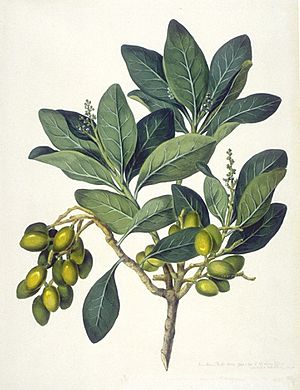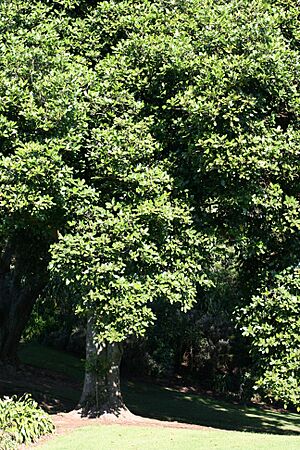Karaka (tree) facts for kids
Quick facts for kids Karaka |
|
|---|---|
 |
|
| Illustration by John Frederick Miller | |
| Scientific classification | |
| Genus: |
Corynocarpus
|
| Species: |
laevigatus
|
The Karaka tree, also known as the New Zealand laurel (Corynocarpus laevigatus), is an evergreen tree. This means it keeps its leaves all year round. It belongs to the Corynocarpaceae family and is found only in New Zealand.
You can find Karaka trees all over the North and South Islands, reaching as far south as Banks Peninsula and Okarito. They also grow on the Three Kings Islands, Raoul Island in the Kermadecs, and the Chatham Islands. Karaka trees are common in places near the coast, often being a big part of the forest there. Many botanists (plant scientists) believe the tree is naturally from only the northern part of the North Island. They think Māori people planted it in other areas near their villages, and then birds helped spread the seeds even further.
The name "karaka" comes from the Māori language. It's also the Māori word for the color orange, which is the color of the tree's fruit. On the Chatham Islands, the tree is called kōpī in the Moriori language. In Hawaii, the Karaka tree has spread widely and is now considered an invasive species, meaning it grows where it's not native and can harm local plants.
Contents
What Does the Karaka Tree Look Like?
The Karaka is a leafy tree with branches that grow straight up or spread out. It can grow up to 15 meters (about 50 feet) tall. Its main stem, called a trunk, can be as wide as 1 meter (about 3 feet).
The leaves are thick and feel like leather. They are shiny and dark green on top, and a lighter green underneath. Each leaf is usually 50–200 mm (2–8 inches) long and 30–70 mm (1–3 inches) wide. They have small stems called petioles that are 10–15 mm long.
In winter and spring (from August to November), the Karaka tree grows strong, upright clusters of tiny flowers. These flowers are about 4–5 mm wide and are usually greenish-cream, off-white, or pale yellow.
The fruit of the Karaka tree is oval-shaped, about 25–46 mm (1–1.8 inches) long. It has pale yellow to orange flesh and contains a single seed. The fruit ripens in summer and autumn (from January to April). Birds, especially doves, love to eat the fruit and help spread the seeds.
Karaka's Role in Nature
This evergreen tree is a favorite spot for smaller birds to sleep during the colder months. It's very important for birds and other animals, including tiny creatures that eat its fruits and help spread its seeds.
The Karaka tree is special because it produces fruit in early summer (January). This makes it a great food source for many animals, especially birds, at a time when most other berries are not yet ready to eat. Long ago, huge birds called moa would have helped spread the seeds. Today, many seeds fall right under the tree, where they often don't grow well because of the shade.
Growing Karaka Trees
It's quite easy to grow a Karaka tree from fresh seeds. However, trying to grow new plants from cuttings (small pieces of the tree) is very difficult. Young Karaka plants are sensitive to frost and cold weather.
The tree often grows by itself in places where the conditions are right. It's a popular tree to plant in gardens and is sold in New Zealand and other places with suitable climates. Māori people also grew these trees widely in the past.
Karaka: Uses and Important Safety Information
The soft, fleshy part of the ripe Karaka fruit is edible. It tastes sweet and has a nice smell. However, the fresh kernels (the seeds inside the fruit) contain a poisonous chemical called karakin.
In the 1800s, people wrote about how Māori carefully prepared the kernels to make them safe to eat. They mentioned that if the processing wasn't done perfectly, people could get very sick. Symptoms included strong fits and severe muscle spasms, which could sometimes leave limbs permanently twisted. In some cases, people even died.
It's very important to know that the berries are poisonous if eaten by dogs and can even cause death. There is also some evidence from beekeepers that the flowers might be harmful to bees, leading to fewer bees and less honey production.
Karaka in Culture
On the Chatham Islands, this tree (known locally as kopi) has a special place in the history of the Moriori people. They used the soft bark of these trees to create dendroglyphs, which are carvings on trees. In the year 2000, a report found 147 kopi trees with these carvings. However, some of them might not have been made by the Moriori people.
See also
In Spanish: Karaka para niños



